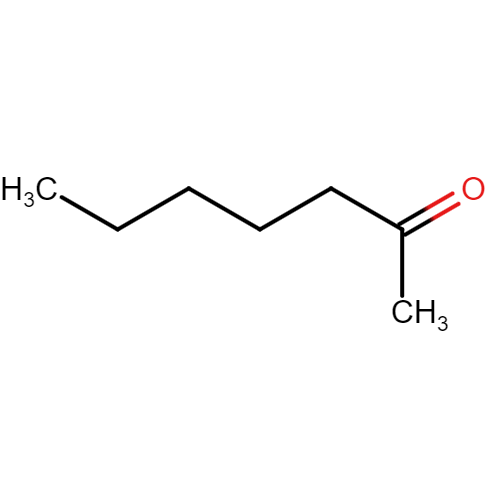2-Heptanone
| Compound Structure: |

|
||||||||||||||||||||||||||||||||||||||||||||||||||
|---|---|---|---|---|---|---|---|---|---|---|---|---|---|---|---|---|---|---|---|---|---|---|---|---|---|---|---|---|---|---|---|---|---|---|---|---|---|---|---|---|---|---|---|---|---|---|---|---|---|---|---|
| Synonyms: | 2-HEPTANONE;Heptan-2-one;110-43-0;Methyl pentyl ketone;Butylacetone;Amyl methyl ketone;Methyl amyl ketone;Methyl n-amyl ketone;n-Amyl methyl ketone;n-Pentyl methyl ketone;Pentyl methyl ketone;Methyl n-pentyl ketone | ||||||||||||||||||||||||||||||||||||||||||||||||||
| Compound ID: | NMPC-241 | ||||||||||||||||||||||||||||||||||||||||||||||||||
| PubChem ID: | |||||||||||||||||||||||||||||||||||||||||||||||||||
| Molecular Formula: | C7H14O | ||||||||||||||||||||||||||||||||||||||||||||||||||
| Canonical SMILES: | CCCCCC(=O)C | ||||||||||||||||||||||||||||||||||||||||||||||||||
| InChIKey: | CATSNJVOTSVZJV-UHFFFAOYSA-N | ||||||||||||||||||||||||||||||||||||||||||||||||||
| About the compound: | N-amyl methyl ketone, also known as 2-heptanone, is a clear colorless liquid with a flash point of 126 °F. It is less dense than water and only slightly soluble in water, causing it to float on water. The vapor of this compound is heavier than air. N-amyl methyl ketone is used as a synthetic flavoring and in perfumes. Heptan-2-one, or 2-heptanone, is classified as a dialkyl ketone with methyl and pentyl as the alkyl groups. It plays a role as a pheromone and is a metabolite in mice. 2-Heptanone has a fruity, banana-like odor and is a colorless, water-like liquid. It is used as a food additive, contributing to the aroma of certain foods and beverages. In mice, 2-heptanone is a urinary component and a pheromone. It has a high affinity for the main olfactory epithelium. Researchers have found that it agonizes a specific olfactory receptor and that this receptor selectively binds to 2-heptanone. This compound has also been investigated for its role in alerting other rats in response to stress and in attracting certain species of worms. In honey bees, 2-heptanone is excreted when they bite small pests within the colony and is used as an anesthetic to disable the pests. Exposure to 2-heptanone can cause irritation of the skin, eyes, and respiratory system, along with symptoms such as headaches, vomiting, and nausea in humans. It is also absorbed through the skin, inhalation, and ingestion. https://en.wikipedia.org/wiki/2-Heptanone GHS Hazard Statements • H226: Flammable liquid and vapor [Warning Flammable liquids] • H302: Harmful if swallowed [Warning Acute toxicity, oral] • H332: Harmful if inhaled [Warning Acute toxicity, inhalation] |
||||||||||||||||||||||||||||||||||||||||||||||||||
| Properties: |
Chemical
and Physical Properties
Source: PubChem |
||||||||||||||||||||||||||||||||||||||||||||||||||
| Source Species: |
Palisota hirsuta |